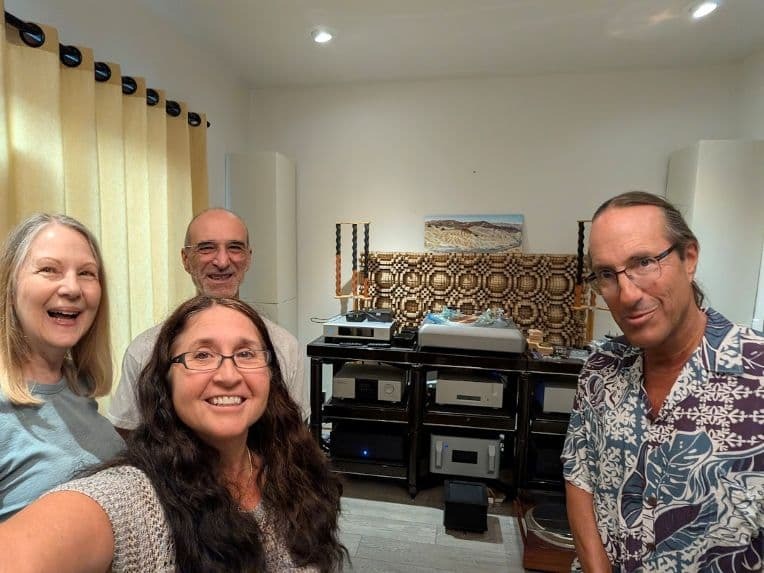
From Left to Right: Debbie, Leslie, Joe, Grant
What girl doesn’t love a new toy? In my case, that toy happens to be a novel take on a music streamer. I know — that might not sound thrilling to most people. But for me, discovering something creative and homegrown by one of our own members made this already valuable system upgrade much more fun.
Let me start from the beginning.
A few months ago, there were rumblings among the Foundation Board about a Raspberry Pi project using Diretta software that David Snyder had been developing. David was tackling what he saw as a flaw in the Roon codec — one that, in his and many people's view, muddied the sound. His theory centered on digital packet size. For anyone who’s followed David’s tinkering over the years, this wasn’t surprising. He’s long used the Pi for audiophile projects and has been a Roon evangelist from the start. But this time, he went further — authoring a
white paper (published in The Muse) explaining the what, why, and how of his new 2-Pi Diretta streamer concept.
I won’t summarize the article here — you should read it if you missed it — but suffice to say, David’s curiosity rubbed off on several Board members. Soon, members of leadership were purchasing or building and testing David’s new streamer for themselves. They were so impressed that many board members even proposed the Foundation buy one for use at our events to add to our lending library (more info to come). At that point, I reluctantly realized I needed to hear it for myself. Down the rabbit hole I went.
The Oregon Experiment
Living in Oregon, I was far from the Bay Area action, so unless a pair of Pis magically appeared at my doorstep, I wasn’t going to hear them anytime soon. Fortunately, Joe Hakim, a former SFAS Board Member, who happens to live about 15 minutes from me, had also caught the Diretta bug and decided to build the setup himself. Eager for feedback, he invited myself, Grant, David Hicks, and a local audiophile named Richard over for a listening session.
I wish I could say it was love at first listen — but it wasn’t. Despite Joe’s amazing, highly resolving system, the sound just didn’t come alive. It was detailed, yes, but a bit clinical — full of information but lacking warmth, fullness, and soul. We mostly all agreed. Joe went back to confer with David Snyder and made some software tweaks and invited us back for a second round.
Round Two: The Upgrade
When we reconvened a few weeks later, Joe had made some changes to the Diretta configuration and changed out both the DAC and streamer for a new EMM Labs DV2i, a combination DAC/streamer that retails for around $35,000. Note that at this point the EMM was not fully broken in. Naturally, we were all curious to see what difference that would make. It was a bit challenging starting with new components, but Diretta now had an even more fierce competitor.
At this point, Diretta stepped up. The sound was warmer, still detailed, but more lifelike. To my ears, it was still a touch bright, but the improvement was undeniable. It wasn’t quite as refined as Joe’s ultra-high-end DAC/streamer, but it easily bested my iFi Zen Streamer ($399) which suddenly sounded so flat by comparison I almost wanted to toss it out the window.
Testing it at Home
Still, I wasn’t fully convinced until I could hear it in my own system, something I would recommend to all. I borrowed the 2-Pi setup from Joe and tried it first on my whole-house system (nothing fancy), and then on my MBL system (see details at end of article). And wow again. The brightness I’d heard in Joe’s setup was gone. On my system, the Diretta streamer was detailed, dimensional, and full of life. Even my outdoor speakers sounded better. Grant commented that my el cheepo outdoor speakers suddenly had bass.
After that, Joe never got his Pis back. I bought the setup from him, and now I use it daily on my whole-house system. When I get around to it, I will probably upgrade all of my other systems as well.
Ease of Use and Reliability
One of my biggest concerns was reliability — especially since the setup consists of two tiny computers. Would it be finicky after a power outage? Would I need to reprogram or update things regularly? Thankfully, the answer was no across the board. It’s been rock solid and totally hands-off, which, for a non-technical person like me, is essential. Nothing kills an audio mood like a crash or reboot.
The Cost and the Takeaway
So what’s the damage? The parts and software together cost just under $600 if you build it yourself. David Snyder may eventually offer pre-built versions for sale. Compare that to the $399 iFi Zen Stream or Joe’s $35K setup, and you start to appreciate what an incredible value this is.
I haven’t yet A/B’d it against other streamers, but I’d love to hear others’ impressions. One thing’s certain: David is onto something here. Affordable, realistic innovations like this — born from passion and community — are what keep this hobby exciting.
Kudos to you, David!
Leslie’s system:
MBL 101e MK2 speakers
Merrill RoseQX preamp
Iconoclast and Hi Fidelity cables
Parasound JC1+ monoblocks
AMR DP777SE DAC
Fiber optic to ethernet
PS Audio Direct Stream Powerplant 15
Hi Fidelity power conditioner